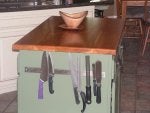My dad made a "butcher block" type top for the island kitchen in our home. It lasted for more than 30 yrs., until he sold the house a few years back.
He took 1"x2" hardwood strips and turned them with the sides facing up (1"). He used two different hardwoods, one dark, one light. The wood was glued and clamped and long threaded rods were run through to minimize warping (different types of wood will sometimes warp as they swell at different rates).
When I last saw the counters, they looked great, outside of the spot where my little brother carved his initials. Dad carved his behind, but mom never let dad sand that part down.
The wood was unfinished, but dad may have oil it. Mom made her biscuits right on top, flouring the whole thing (she cooked for EVERYBODY.)
Anyway, I like the idea.







